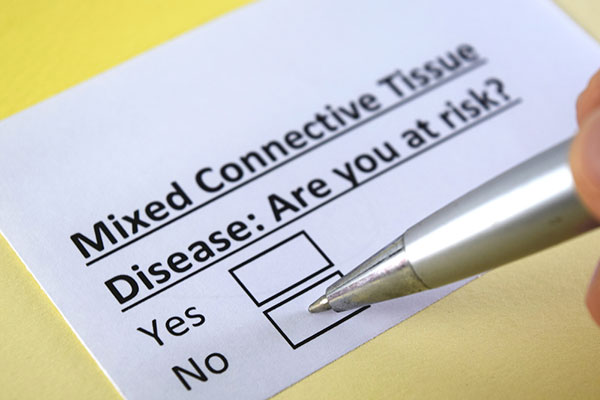
Mixed connective tissue disease (MCTD) is a health condition characterised by a combination of features seen in many disorders, such as systemic lupus erythematosus, scleroderma, polymyositis and systemic sclerosis. It is not uncommon to find that people with MCTD also have Sjogren’s syndrome.
For this reason, MCTD is sometimes called an overlap disease. But the symptoms of these different diseases don’t usually appear all at once. Instead, symptoms materialise over several years, making diagnosing MCTD challenging.
Many patients will notice early signs and symptoms of MCTD, which often occur in the hands. The fingers become inflamed and swollen, and fingertips become numb and white, especially when exposed to cold temperatures. Late-stage MCTD symptoms can affect the organs such as the lungs, heart and kidneys.
At present, there is no cure for MCTD. Once diagnosed, treatment for the condition will depend on how severe the symptoms are and if any body organs are affected.
What triggers mixed connective tissue disease?
Mixed connective tissue disease is an autoimmune disorder. The actual cause isn’t known, but it is triggered by your immune system mistakenly attacking healthy cells. The immune system attacks the tissue fibres that build the support framework of the body. While some people with MCTD have a family history of the condition, a direct genetic link hasn’t been established.
MCTD can occur in people of any age, but it appears to be most prevalent in women under 50. Those diagnosed with MCTD can go on to develop Raynaud syndrome, joint pains, various skin abnormalities, muscle weakness, and problems with internal organs.
How serious is mixed connective tissue disease?
The seriousness of each person’s MCTD depends on their diagnosis. The diagnosis is based on the symptoms, their severity, and whether or not the body’s organs are affected.
Treatments for MCTD depend on its severity and may include nonsteroidal anti-inflammatory drugs, hydroxychloroquine, corticosteroids, immunosuppressive drugs, or a combination of medications.
MCTD is more common in women and is a disease that occurs worldwide, affecting people of all ages, often peaking during adolescence and the 20s.
How long can a person live with mixed connective tissue disease?
The prognosis for a patient diagnosed with MCTD largely depends on their individual symptoms. Generally, the ten-year survival rate is around 80 per cent, but the prognosis is worse for people with mainly symptoms of systemic sclerosis and polymyositis.
The leading causes of death in people with MCTD include pulmonary hypertension, kidney failure, and heart disease. The lungs are affected in up to 75 per cent of people with MCTD, causing fluid to collect in or around the lungs, causing abnormal lung function. Pulmonary hypertension, a condition in which blood pressure in the arteries of the lungs is abnormally high, is a significant cause of death for people with MCTD.
Living with MCTD can be unpredictable because you may go for a long time with well-controlled, manageable, and sometimes hardly noticeable symptoms. Then you may experience flares where symptoms worsen, or you develop new symptoms never experienced before. Flares can also be mild and short, lasting just a few days before dissipating, or they can be prolonged and uncomfortable.
What causes MCTD flare-ups?
An MCTD flare is marked by an increase in symptoms that can vary in severity. Flares can be characterised by periods of zero symptoms followed by unexplained flares. Not a lot is known about triggers for MCTD flares, but they can include pregnancy, stress, emotional distress, cold exposure, or switching or ceasing medications.
If you have MCTD and plan to get pregnant, it can be best to talk to your healthcare provider to ensure that you receive the best care and treatment to keep you and your baby safe and healthy.
It is believed that stress can be a significant trigger for an MCTD flare. Collected patient data indicates that stress is one of the essential factors in managing their condition. Stress-related flares can be caused by financial worries, work or career stress, traumatic life events, overworking and overreaching oneself to meet targets.
Cold exposure is another significant cause that can exacerbate current or past symptoms. Sticking with your treatment plan for MCTD is key to helping minimise flares and reducing their impact on your life. Seventy-four per cent of patients experienced a lower risk of developing severe flares who remained on their treatment plan, including prescribed hydroxychloroquine, than those that went off their prescription medication.
What is the best treatment for MCTD?
Managing the symptoms of MCTD with an effective treatment plan is essential if you want to minimise its impact on your life. However, treatment for MCTD will depend on your individual symptoms and their severity. There is no one-size-fits-all approach to treating MCTD.
Your treatment plan may also include management of other autoimmune conditions you may have. For example, if you have arthritis, you may be prescribed disease-modifying antirheumatic drugs (DMARDs) to manage your condition.
Some standard medications are prescribed to help manage the various symptoms of MCTD, but these drugs aim to help prevent the disease from causing any further harm to your body and ease your symptoms.
Most people with MCTD respond well to treatments with systemic steroids, disease-modifying antirheumatics (DMARDs) like hydroxychloroquine or methotrexate, or immunosuppressive drugs like cyclosporine.
Your healthcare provider may recommend you take NSAIDs to help ease the pain and inflammation caused by a flare. But it will help you to work closely with your healthcare provider to devise the most effective treatment plan to manage your condition. It is also essential to inform your doctor if you develop new symptoms you haven’t experienced before so your medication can be adjusted to help control them.
You can also make diet and lifestyle changes to help improve your health and minimise the severity of your flares. Working with a doctor specialising in inflammatory health conditions, such as Dr Bhaudauria, is the best way to live your most comfortable life with MCTD.
By treating yourself well, following a personalised plan, resting when you need to, exercising regularly and eating well, you will be helping to keep your body as healthy and robust as possible while managing MCTD.
Booking a private consultation with Dr Bhaudauria at one of his London-based clinics is your first step to a better quality of life while living with MCTD. Do not hesitate to contact us to book an appointment.
Article by Dr. Naveen Bhadauria



